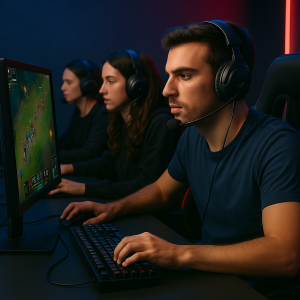How Game Optimization Software Improves LoL FPS and Latency
 League of Legends (LoL) is one of the most popular multiplayer games in the world. But, like any fast-paced competitive game, performance matters. Low FPS (frames per second) and high latency (lag) can cost you kills, objectives, and even matches. That’s where game optimization software comes in. These tools can boost your PC performance, helping you play more smoothly and respond faster in-game. For players looking to climb the ranks without starting from scratch, many choose to buy LoL smurf accounts to skip early grind and jump straight into higher-level gameplay.
League of Legends (LoL) is one of the most popular multiplayer games in the world. But, like any fast-paced competitive game, performance matters. Low FPS (frames per second) and high latency (lag) can cost you kills, objectives, and even matches. That’s where game optimization software comes in. These tools can boost your PC performance, helping you play more smoothly and respond faster in-game. For players looking to climb the ranks without starting from scratch, many choose to buy LoL smurf accounts to skip early grind and jump straight into higher-level gameplay.
Here’s how game optimization software improves LoL FPS and latency—and why it matters.
What Is Game Optimization Software?
Game optimization software is designed to improve your PC’s performance while gaming. It works by reducing background processes, optimizing system settings, and allocating more resources (like CPU and RAM) to your game. Some popular tools include Razer Cortex, NVIDIA GeForce Experience, and MSI Afterburner. Others like WTFast and ExitLag focus specifically on improving internet connectivity and reducing ping.
While each program has its own features, the core idea is the same: prioritize the game, eliminate distractions, and make everything run as efficiently as possible.
Boosting FPS in League of Legends
FPS determines how smooth your game looks and feels. Higher FPS means better visual responsiveness, which helps you react quickly during fights, skill shots, and objective plays.
Here’s how optimization software helps:
1. Shutting down background apps:
Most optimization tools scan your system and shut down unneeded background applications. Browsers, updaters, and even some antivirus programs can eat up CPU and RAM in the background. More system power is available for LoL when those are paused or closed.
2. Prioritizing LoL in your system:
Some tools let you set League of Legends as a “high priority” process. This means your operating system gives LoL more CPU time and memory bandwidth, helping it run more smoothly—especially on older machines.
3. Managing in-game settings:
A few optimization tools adjust your game’s settings to match your hardware. This can mean reducing shadows, lowering resolution, or tweaking effects to improve performance without noticeable drops in quality.
4. Overclocking (with caution):
Programs like MSI Afterburner let advanced users tweak GPU and CPU speeds for more power. While this should be done carefully (and not by beginners), a well-managed overclock can provide a solid FPS boost.
Reducing Latency and Ping
Latency refers to the time it takes for your actions to register in the game. In online games like LoL, latency is affected by your internet connection, server distance, and network congestion.
Some optimization software is specifically built to reduce ping and improve connection stability.
1. Route optimization:
Programs like WTFast, ExitLag, and NoPing reroute your internet traffic through optimized paths to the game server. This avoids crowded or inefficient network routes, reducing the time your commands take to reach Riot’s servers.
2. Stabilizing your connection:
These tools can also reduce packet loss and jitter—two major causes of lag spikes. Even if your ping looks fine on paper, inconsistent delivery of data packets can lead to rubberbanding or delayed inputs. Optimization tools help smooth this out.
3. Blocking background bandwidth usage:
Some general optimization tools monitor your network and stop unnecessary downloads or cloud syncs while gaming. This ensures that your bandwidth is focused on the game, not your Google Drive backup or Windows update.
Real-World Impact for LoL Players
The difference may not always be dramatic, but even small gains in FPS or ping can impact your gameplay. A bump from 45 FPS to 60 FPS makes combat feel more responsive. A ping drop from 80ms to 40ms gives you faster skill execution and better positioning.
For competitive players or ranked grinders, these small advantages add up. Consistency is key, and performance optimization can help reduce variables that affect your in-game focus.
Even casual players benefit. Better performance means less frustration, fewer crashes, and more enjoyable matches.
Is Game Optimization Software Worth It?
Game optimization software can make a noticeable difference if you’re running LoL on a mid-range or older PC. If you have a powerful rig and solid internet, the impact may be minor—but still useful, especially for keeping things running smoothly in the background.
Keep in mind that no software can fix every issue. Optimization tools can only go so far if your hardware is outdated or your internet is unstable at its core. But as part of a well-rounded setup, they’re a smart and often free way to get better performance without upgrading your gear.
Final Thoughts
Game optimization software won’t turn your setup into a high-end gaming machine—but it can help you get the most out of what you have. For League of Legends players dealing with stuttering, low FPS, or frustrating lag, these tools are a practical way to smooth out gameplay and stay focused on winning.
In a game where every second counts, better performance isn’t just nice—it’s part of the strategy.
